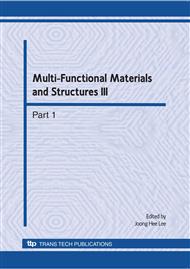p.251
p.256
p.260
p.264
p.268
p.272
p.276
p.280
p.284
The Effect of Visible Light-Activated TiO2 Thin Film on Nosocomial Pathogens
Abstract:
Many methods had been developed to disinfect or sterilize the medical equipment or hospital environment for controlling the spread of nosocomial pathogens. This study was aimed to evaluate the effect of titanium dioxide (TiO2) thin film on preventing nosocomial infection. Firstly, TiO2 thin film was prepared by using the modified impregnation method and further analysis by field-emission scanning electron micrographs and X-ray diffractometer. The nano-size and Anatase crystal structure were confirmed. By using visible light activation of TiO2 thin film for 30 min, the inhibition of Enterococcus faecalis, Streptococcus bovis, Streptococcus agalactiae, and Staphylococcus aureus by TiO2 thin film treatment were 27.4%, 73.3%, 56.6%, and 9.4%, respectively. In addition, several important Gram negative bacteria causing nosocomial infection were also investigated. The inhibition rate of Pseudomonas aeruginosa, Klebsiella pneumoniae, and Escherichia coli were 32.5%, 31.3%, and 22.4%, respectively. The results revealed that TiO2 thin film activated by visible light may be useful for decreasing nosocomial infection.
Info:
Periodical:
Pages:
268-271
Citation:
Online since:
August 2010
Price:
Сopyright:
© 2010 Trans Tech Publications Ltd. All Rights Reserved
Share:
Citation:


